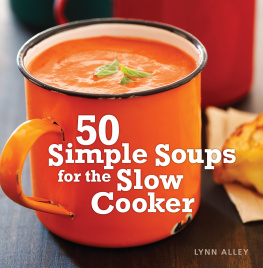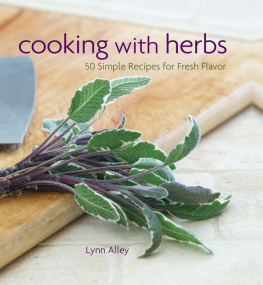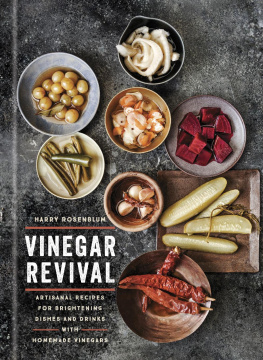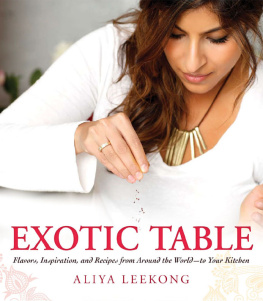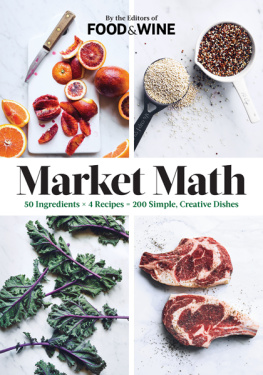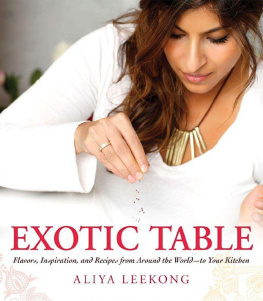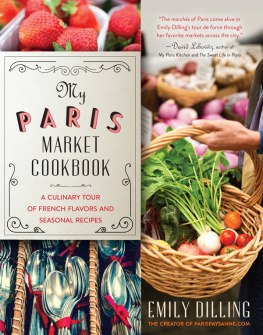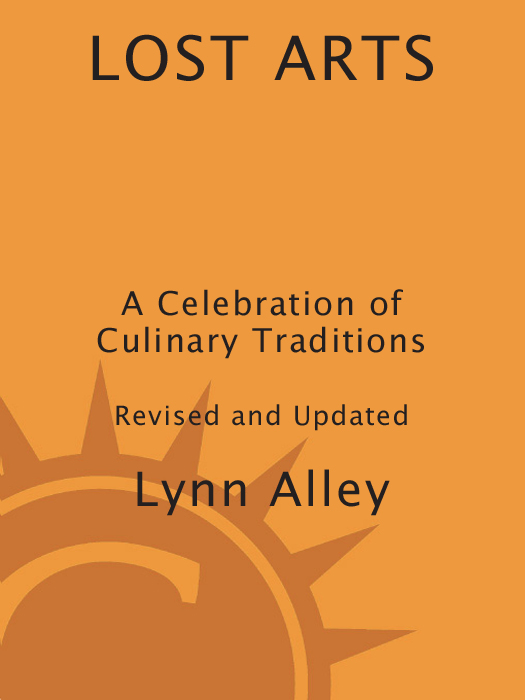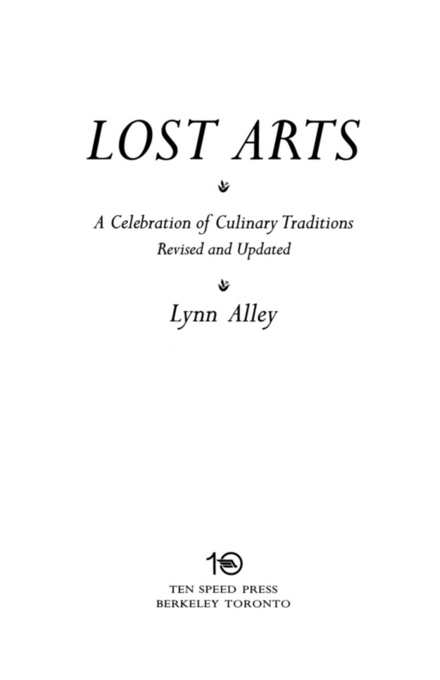Copyright 1995, 2000 by Lynn Alley
All rights reserved.
No part of this book may be reproduced in any form, except brief excerpts for the purpose of review, without written permission of the publisher.

TEN SPEED PRESS
Box 7123
Berkeley, California 94707
www.tenspeed.com
Distributed in Australia by Simon and Schuster Australia, in Canada by Ten Speed Press Canada, in New Zealand by Southern Publishers Group, in South Africa by Real Books, and in the United Kingdom and Europe by Publishers Group UK.
Interior illustrations by Bonnie Engberg.
Some of the recipes contained herein have appeared in the Herb Companion Magazine, Cooks Illustrated, and the San Diego Tribune.
The confiture pan appearing on the cover was provided by Sur La Table (www.surlatable.com).
LIBRARY OF CONGRESS CATALOGING-IN-PUBLICATION DATA
Alley, Lynn.
Lost arts : a cooks guide to making vinegar, curing olives, crafting fresh goat cheese and simple mustards, baking bread, and growing herbs / Lynn Alley.Rev. and updated
p. cm.
eISBN: 978-0-307-81478-4
1. Condiments I. Title.
TX819.A1 A4 2000
641.6382dc21 00-023176
v3.1
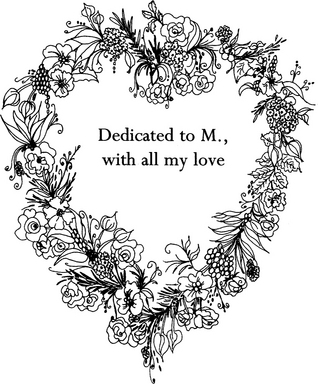
The author wishes to thank:
My friend Bonnie Engberg for her constant loving support and her beautiful illustrations.
My agent, Julie Castiglia, without whose sound advice and whole-hearted support, Lost Arts wouldnt be.
Mariah Bear, the best managing editor in the world, whose dry humor and quick wit have made the completion of Lost Arts a piece of cake.
Rebecca Pepper for a very thorough editing job, and Sarah Levin for a lovely book design.
My dear friend and neighbor, Helen Mildner, who willingly devours and comments upon every word I write.
Deborah Madison and Beth Hensperger for their inspiration and friendship.
Julie Bennett for her direction and encouragement on the new chapters in this second edition.
Beau, Crystal, and Princess for warming the hearth.
Contents
CHAPTER 1: The Old Bat,
or How I Came to Make the Best Olives Ever
CHAPTER 2: Little Green Friends,
or How to Grow and Cook with Fresh Herbs
CHAPTER 3: Mrs. Caviglias Surprise,
or How to Make Mustard at Home
CHAPTER 4: Sour Grapes,
or How to Make Good Vinegar at Home
CHAPTER 5: The Poor Mans Cow,
or How to Make Goat Cheese Chez Vous
CHAPTER 7: The Fat of the Land,
or How to Make Flavored Butters and Oils
CHAPTER 8: Blue Mango Jam,
or How to Make Preserves
CHAPTER 9: All My Children,
or How to Make Good Wine at Home
Introduction
LOST ARTS is a book about reviving the lost culinary arts that were once the mainstay of the home cook. These arts were born ages ago in the Old Country and were kept alive in the new by the Italian and Greek grandparents of my childhood. They connected people to the earth and, when well done, would add an indescribable depth to dishes constructed upon their foundation.
Even today, vinegar made at home is better than anything you can purchase in a market or gourmet shop. A fresh cheese made with raw milk is an unbelievable treat, and one that, when you have tasted it, will ruin you for life! Breads made from grains milled in your own kitchen have an indescribable freshness and complexity of flavor that cannot be obtained in any other way. They taste and smell like the materials from which they were crafted and not like plastic wrappers, spanking clean machinery, and the cushions of your sofa. The pleasure of curing your own olives lies not only in the moment of consumption when, coated with good olive oil and freshly chopped herbs, you pop them into your mouth in tandem with a sharp cheese and a cool, crisp wine, but also in the moment when they begin to give up their wonderful aroma to the first water soak.
In retrospect, Id say my own ruination began in the 1950s at the tables of Sara Quanchi and Mae Gorman. Aunt Sara and Aunt Mae were my mothers aunts. They lived in San Jose, which at the time was considered nothing short of the sticks by San Franciscans. I remember happily our family outings to San Jose; they afforded me my first opportunity to eat real food. I remember sitting at Aunt Maes bounteous table. All meals in San Jose were served family style, with large oval bowls filled with mountains of green beans, mashed potatoes, corn, tomatoes, and what have you, all fresh from the garden. I remember my excitement the day Aunt Mae decided I was old enough to appreciate the garden. She took me outside and proudly showed me tomatoes, herbs, and, by golly, the very string beans which we were to have for dinner that afternoon!
This was the first moment I remember consciously registering any connection between the food on my table and the land from which it came. The food on my table at home came from the grocery store. But the food in San Jose came from someplace different, someplace special. It tasted different, and the very act of eating it was a special occasion.
Outside these forays into the country, my world was full of food that came from the grocery store. It was only years later, in the late 1960s, when I moved away to attend college, that the lid really blew off the can of my food world. I had the grave misfortune (now I was really going to be ruined) to move into a rented room near the corner of Spruce and Vine in Berkeley, California. Spruce and Vine in Berkeley, California, may mean nothing to you. But just around the corner, at Shattuck and Vine, a young Alice Waters had opened her now famous restaurant, Chez Panisse. As a special birthday treat, my boyfriend and I went to dinner there. We walked away whistling under our breath, Man, that was some restaurant! It was that same Shattuck and Vine, by the way, which housed Peets Coffee and Tea, from which I still mail-order my coffee today, it being the best available; the same Shattuck and Vine where Sahag Avedisian opened the Cheese Board while waiting for the revolution, and the same Shattuck and Vine near which Alice Medrich would open Cocolat a couple of years later. A veritable piggys paradise.
It was there that I planted my first garden. I remember with pleasure the first physical labor I ever really encountered, digging up a small plot in my Spruce Street backyard (a plot fondly referred to by us residents as the back forty), composting all my kitchen scraps, and planting my own wonderful vegetables. I made my first jam from blackberries that crawled over the back fence and apricots from Anne Padovers tree. I made a memorable pork and cabbage soup with cabbage and tomatoes only minutes out of the garden, and spent hours reading Rodales Organic Gardening magazine and dreaming about gardens. Yes, Spruce and Vine ruined me for life!
After a number of years living and traveling in Europe (and if France wont ruin you, nothing will!), I came back to settle in California and had the time and wherewithal to pursue my interest in the lost arts. I began searching for information about making vinegar, curing olives, and making simple goat cheeses. I found almost nothing. Only a few scraps of information here and there gave the curious home cook any clues to go on. So in addition to pursuing my own interest in these techniques, I began to teach others how to practice the lost arts. My classes have grown in popularity, as has the desire of the general public to know more about making things from scratch, and as a result


